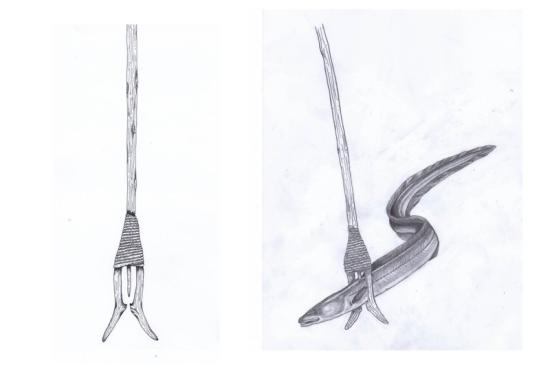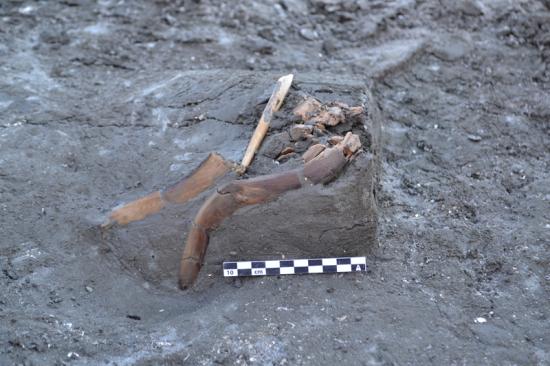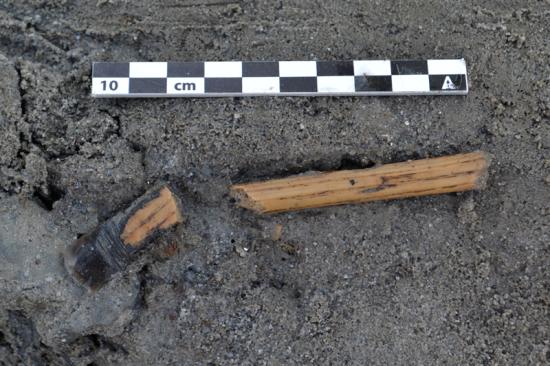Source - http://www.pasthorizonspr.com/index.php/archives/04/2015/ancient-fishing-leister-found-together-with-its-spearing-point

Illustration of fishing leister and how it works. Image: Museum Lolland Falster
Prongs and a bone point from the Late Stone Age have been found together, proving to archaeologists that prehistoric leisters really had a centred point for spearing.
At the archaeological investigations ahead of the construction of the future Fehmarn Belt Fixed Link, archaeologists from Museum Lolland-Falster in Denmark have found an object that has them very excited. Jammed into the seabed was the lower part of a fragmented fishing leister consisting of both lateral prongs and a bone point slightly offset between them. It has long been presumed that there was a link between lateral leister prongs and bone points, but this is probably the first time the connection has been documented in practice. The find thus confirms a theory that has been supported by archaeologists for decades.

The fishing leister with bone point. Image: Museum Lolland Falster
“It is quite amazing that we have made a find that can help prove an old theory. So far, we have found a large number of individual leister prongs and bone points, but when we found them combined, it was quite remarkable. Imagine that! At last we are able to confirm the old theory because of this find,” says Søren Anker Sørensen archaeologist at Museum Lolland-Falster.
First well preserved leister find
In order to understand the archaeologists’ enthusiasm, we need to start in a completely different place – the locality of Næbbet near the island of Ærø some 40 years ago. It was here that diving amateur archaeologists for the first time ever found a relatively well preserved leister, where parts of both of the lateral prongs had been preserved along with a piece of the shaft to which it was tied. Previously, only individual leister prongs had been heard of, but this find was proof that they belonged together in pairs – as we know from more modern eel leisters. However, the find immediately gave rise to a new question: Had the leisters been equipped with a centred point, as in modern leisters? The piece from Ærø did not have such a point, and there were no traces of one either, so archaeologists have been discussing since then whether a leister could work without a point.
“Unfortunately, the string winding and the shaft were missing, but the position of leister prongs and bone point in relation to each other can only be interpreted as the result of a leister that has broken off – the pieces were still sitting at an angle in the old seabed. This means that we can now say with a greater level of probability that Stone Age fishing leisters had both lateral wooden prongs and a centred bone point, although a tiny amount of uncertainty remains until we find a complete preserved leister,” Søren Anker Sørensen continues.
Many interesting finds
During the Late Stone Age, the area where the special find has been made was located directly on the coastline in the peaceful lagoon area east of present-day Rødbyhavn. The topography made the area very attractive to Stone Age people as fishing in the coastal zone was a secure means of putting food on the table. The coastal zone stands out clearly in the locality, with an approx. 20 m wide belt of scattered stones, in between which a number of artefacts have been found in the form of flint and bones – with an increasing find intensity closest to land.
Immediately south of the scattered stones, a wattle fence has been found, which originates from one of the fixed gillnets on stakes that Stone Age fishermen set up in selected places close to the coast. The wattle fence stretches across about 25 metres in an arch, forming a U that opens towards the lagoon. It consists of long, slender sticks that have been intertwined closely among the almost equally slender vertical uprights. These have been placed at a distance of just 25 cm. Whether the gillnet was originally placed on this site, or whether it has washed in from the sea or been brought in for repairs or maintenance is still uncertain. The fine structure might indicate that its function was different from the more crude fishing weirs that are known from other localities in the area, and the same applies to the U-shape, if you presume that this is the original position.

Part of a hafted arrow arrow. Image: Museum Lolland Falster
The extreme end of a hafted arrow has also been found, which is equally as well preserved as the fishing leister. The piece measures about 10 cm and has broken into two bits, but the point is intact with the arrowhead attached and adhesive and binding preserved, which is another thing that is only known from a very few other cases.
The excavation has not yet been completed, and many unanswered questions remain about the locality and the finds made there. However, it is possible to get close to the locality and the museum’s archaeologists on 25 April 2015 when the museum opens the excavation for visitors who can learn more about the exciting traces from the past.
Read more about the open excavation here (in Danish): http://www.aabne-samlinger.dk/femernforbindelsen/femernforbindelsen/nyheder/2015/aaben-udgravning/